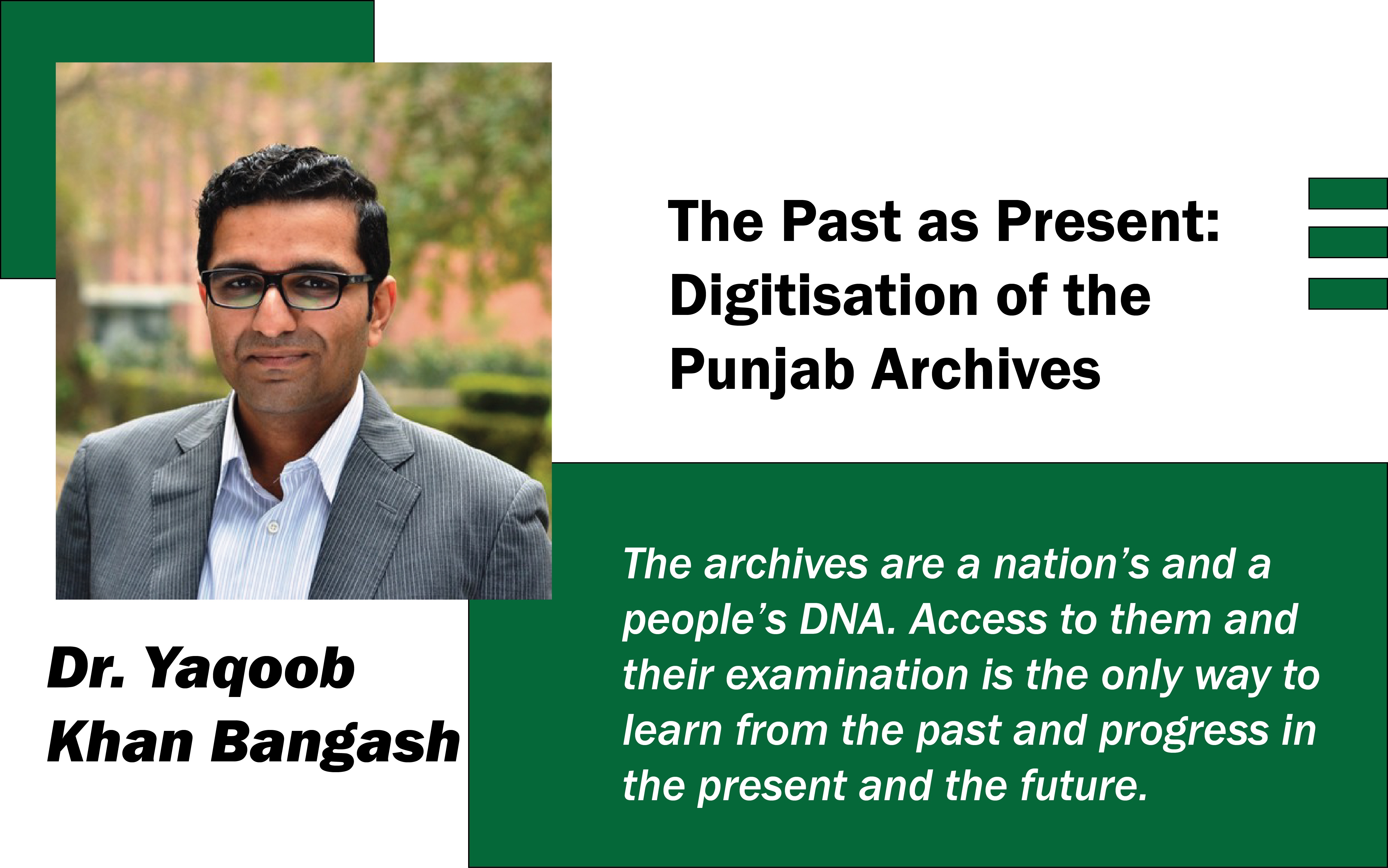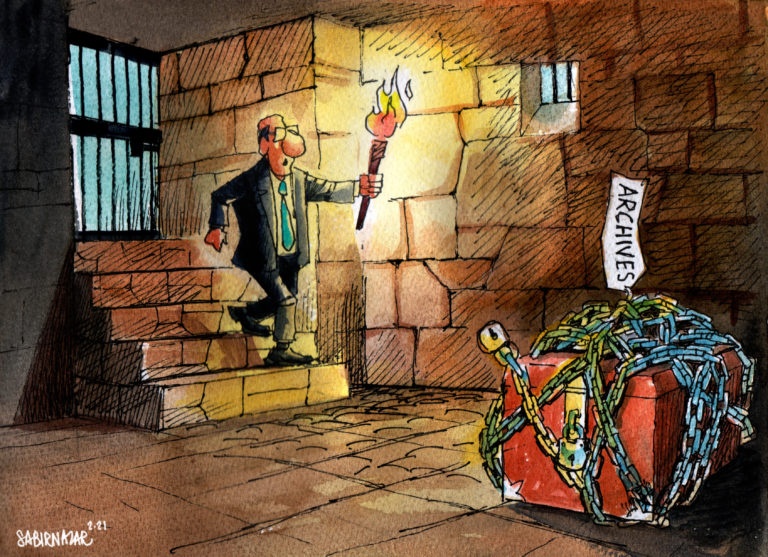The archives are a nation’s and a people’s DNA. Access to them and their examination is the only way to learn from the past and progress in the present and the future.
The Past as Present: Digitisation of the Punjab Archives
By
Yaqoob Khan Bangash
History ‘is continuous dialogue between the present and the past,’ once noted the acclaimed historian E.H. Carr. Thus, the present cannot be untangled from the past, while the future depends on how the present is being shaped. History, and its study, permeates every facet of our state and society.
History research in Pakistan has existed in a paradox. On the one hand it is relegated as a useless subject which does not improve job prospects and it is claimed that only those who can’t get into better disciplines study it, while on the other hand, after religion, it is the most contested and charged subject. Despite several limitations, however, history research and teaching has managed to survive and has recently even seen good growth.
In the study of history (and life, I would even argue), the role of the archives is central. They not only document the past, but within its holdings are several ignored, missed, lost, and underrated voices, which historians continuously strive to uncover. Not just big revelations about states and important people, but tales of everyday life, keep archives at the core of a nation’s and a society’s life and progress.
In Pakistan, access to archives has been the most important reason for the retardation of historical research. Since inception the state has guarded the archives as if there is some smoking gun inside which will bring everything down. Regardless of laws concerning declassification of documents after a certain number of years, regulations to transfer old files from departments to the archives, and rules mandating access, entry let alone access to the holdings of the archive remain fraught in the country.
Recently, several repositories in Pakistan have improved access to at least some documents especially through the medium of digitisation. Led by the National Documentation Wing in the Cabinet Division, several archives in Peshawar, Karachi and even Quetta, have initiated and even given online access to several hundred documents. The only exception is the largest and oldest archive in the country, the Punjab Archives.
In 2015-16, I was approached by Dr Umar Saif, the founding Vice Chancellor of Information Technology University and the then Chairman of the Punjab Information Technology Board, to ask if I was interested in helping him start the digitation of the Punjab Archives. Dr Saif had heard of my digitising an old and rare newspaper at Forman Christian College in collaboration with the British Library, and wanted me to bring my expertise and experience to work on this important project. Immediately excited by the prospect of this pioneering work, I agreed.
Our first hurdle—and it was quite formidable—was to convince the government, and especially the secretary of the archives department that it was a worthwhile project. While for us the ability to digitise and make accessible the treasures of the Punjab Archives was obvious, the civil servants running the department were suspicious. The Punjab Archives holds the records of the British Indian period dating from about 1804, while it also has valuable Persian record from the Sikh Court between 1799-1849. Most of its major record ends in the late 1940s (though there are several hundred unopened boxes of post-1947 material still locked up), and yet the scare was that perhaps it contained something which would bring the government, perhaps even the whole edifice of the country, down! In the end, we got the project approved not because the concerned bureaucrats saw its value, but because we were patient and persistent.
Over a years’ effort resulted in a number of summaries being moved to the Chief Minister through the Chief Secretary, many versions of the PC-1 being written and re-rewritten, several false starts for the Departmental Development Sub-Committee meetings, and finally the formal approval of the two-year pilot project by the end of 2017.
With the project approved, we inaugurated it with an international seminar on ‘Knowledge Architectures and Archives,’ in collaboration with Columbia University’s Group for Experimental Methods in the Humanities and several scholars from across the world. Held on March 12-13, 2018 this seminar brought historians, archivist from all major repositories in Pakistan, activists and others for two days of robust deliberation on the role and importance of the archives and the seminal part digitisation could play in not only its usage but also impact. Led by the then Additional Chief Secretary Omar Rasul, who literally opened up the archives building, this seminar exhibited the openness of the government to give full and unfettered access to the Punjab Archives.
Energised by the seminar, we started a seven-week course at the IT University for our staff called ‘Certificate in Archival Studies.’ The first of its kind in the country, this course taught our small team the critical tools for the preservation, cataloguing, and digitation of the archives. We also emphasised the ethical element of archiving where hiding material, misplacing it, or hampering access, was discouraged. In collaboration with the British Library the team also practically learnt how the digitisation process is itself conducted, its best practices, workflow arrangements, cataloguing and e-tagging, and finally its online access. The course, gleaned from archives courses around the world, was taught by the best faculty from across Lahore, giving our team the best training available.
With a suitably trained team we then embarked on the first critical task of perseveration. Even though Anarkali’s tomb, which houses a large part of the Punjab Archives, is a large, spacious and well-ventilated building, the ravages of time and neglect were clear. Numerous cupboards had not been dusted in decades, no cataloguing had been done in years, and frequently files were just stuffed into shelves and were deteriorating. Starting with the files of 1857—the year of the Great Revolt, we began the process of cleaning and preserving documents, so that even after digitisation the originals are saved in suitable conditions. Led by a PhD scholar in Chemistry, work commenced in the summer of 2018, to save our heritage from being lost.
The second task was to prepare the files for digitisation. This meant following a sensible and easy to find cataloguing scheme. The last proper catalogue of the documents had been done under the British and so a new scheme had to be devised. Thus, we decided to follow the British Library cataloguing scheme, mainly because the files in the Punjab Archives were usually back files of those held in London. Using the same scheme would help scholars find the material in both London and Lahore. Our ultimate aim here was to connect the London and Lahore catalogues so that scholars could access the materials easily in either city. One research team member also pioneered a post-1947 cataloguing scheme using the same principles as the British Library.
Since the big scanners for the ultimate digitisation had yet to be procured, we began test scans of hundreds of documents using small scanners. This was essential to ensure that the staff was fully trained and that hitches in the workflow could be identified early. The importance of foliating, quality checking each and every page of a document, double checking the e-tagging of documents, and ensuring its easy accessibility online, were all tried and tested during this period.
Despite its large holdings and significant staff, access to the Punjab Archives had always been a lament of scholars. There were often complaints of uncooperative staff, the deliberate concealment of files, and outright rudeness. Thus, in order to change the perception, we initiated a series of exhibitions in the Anarkali’s tomb to showcase not only the great holdings of the archives but also to announce that it was now open for everyone.
Our first exhibition was titled ‘Fear and Vengeance in 1857,’ and it premiered on May 31, 2018. Curated by Ms Sadaf Chugtai, the exhibit tied the visual imagery of prints from the period with documents relating to the Great Revolt of 1857, especially focusing on the Punjab and the theme of fear and vengeance. For the first time perhaps in the history of the archives, it was opened on the weekends and in the evening so that a large number of people could come and view it. The exhibit brought people from all walks to life—mostly for the first time—to the archive, and they were all taken in my its massive and varied collection. Several trips by schoolchildren introduced the archive to our future generation and instilled in them a yearning for knowing our past.
As the preservation and sorting work progressed beyond 10,000 files, we hosted another exhibition, entitled: ‘The Hollow Crown: Archives on the fall of the Mughal Empire.’ This time it was curated by me and in addition to the pairing up of Charles Ball’s superb prints, and the invaluable documents, I also added couplets from Urdu poets lamenting the demise of the Mughal Empire and the ruin of Delhi. Calligraphically written couplets from poets like Ghalib, Dagh, Sauda, Zauq, and of course the last Mughal Emperor, Bahadur Shah Zafar, were then hung in the Mughal era tomb with classical music being played in the background to give a really poignant feel to the exhibit. Scores of people again came to see the exhibit and certainly yearned for more!
By the time I left for my fellowship in September 2018, several milestones had been achieved. A world class seminar had kicked of the project giving it a wide scope and depth, a core staff had been trained to international standards, a modern cataloguing scheme had been devised, the sorting of over 10,000 files had been completed, and two exhibitions had brought thousands of people to the archive and showcased its rare holdings.
However, since September 2018 there has been little progress on the project. Nearly three years have passed since I completed my term as Project Director, and no digitised documents have yet been freely available on an online portal. The post of Project Director is still empty and will perhaps be given to someone internally so that nothing happens, while even if digitisation takes place, nothing will actually be made accessible, and the documents would be hid behind screens of authorisations and payments.
The archives are a nation’s and a people’s DNA. Access to them and their examination is the only way to learn from the past and progress in the present and the future. In Pakistan—still a relatively new country with severe challenges, the role of the archives is even more critical. Only an open access policy, where materials are digitally and freely available and the originals expertly preserved, will aid not only the development of history and allied subjects, but also the country itself. The largest archival repository in Pakistan is crying for help, and unless radical interventions are made, its fate might just be like the forlorn Anarkali in whose tomb it has survived for so long.
The writer is a historian and was Project Director of the Punjab Archives Digitisation Project, 2016-18. He can be contacted at: Yaqoob.bangash@gmail.com and tweets @BangashYK


